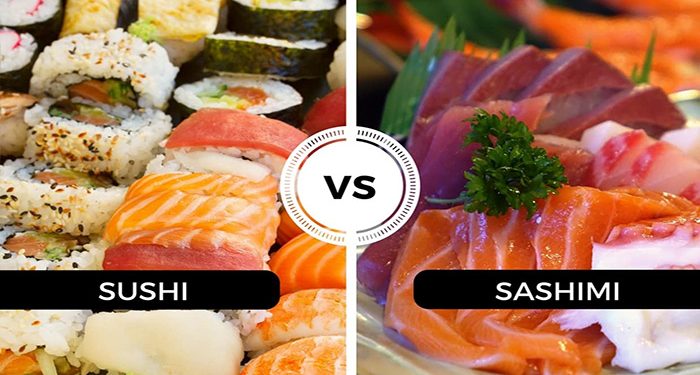If you’ve ventured into a sushi restaurant, you likely encountered the term “sashimi” on the menu, prompting the question: “Is sashimi simply a type of sushi?” Despite their shared Japanese roots, these two culinary delights are distinct dishes. To unravel the nuances between sushi and sashimi (with a nod to nigiri as well), let’s delve into the unique characteristics that set each of these Japanese delicacies apart. Read here Sushi Vs Sashimi vs Nigiri What’s The Difference.
What is sushi?
Sushi is a traditional Japanese dish characterized by vinegared rice, combined with various ingredients such as seafood, vegetables, and occasionally tropical fruits. The most common type of sushi is called “nigiri,” where bite-sized portions of seasoned rice are topped with a thin slice of raw or cooked fish, or other toppings, and often secured with a small strip of seaweed (nori) or a band of thin, translucent white seaweed called “kanpyo.” Sushi can also come in other forms like “maki” (rolled sushi with rice and ingredients wrapped in seaweed) or “sashimi” (sliced raw fish without rice). Soy sauce, pickled ginger (gari), and wasabi are commonly served as accompaniments to sushi.
What is sashimi?
Sashimi is a Japanese dish that consists of thinly sliced, fresh, raw seafood or occasionally cooked seafood, presented without rice. Unlike sushi, which involves a combination of seasoned rice with various ingredients, sashimi places the primary focus on showcasing the delicate flavors and textures of the raw or lightly cooked fish or seafood. The slices are typically elegantly arranged on a plate and may be accompanied by garnishes such as shredded daikon radish, pickled ginger, and wasabi. Sashimi is appreciated for its purity and the art of highlighting the natural essence of the seafood without the rice or seaweed components found in sushi.
What is nigiri?
Nigiri is a specific type of sushi that consists of bite-sized mounds of vinegared rice topped with various ingredients, often seafood. The term “nigiri” translates to “two fingers” in Japanese, referring to the size and shape of the rice portion. A thin slice of raw or cooked fish, or sometimes other ingredients like tamago (sweet Japanese omelet), is placed on top of the rice. Sometimes, a small amount of wasabi is applied between the rice and the topping, and the whole piece may be bound together with a strip of seaweed (nori) or a band of thin, translucent white seaweed (kanpyo). Nigiri showcases the balance between the seasoned rice and the featured topping, creating a harmonious and flavorful bite.
How to make sushi?
Making sushi at home can be a fun and rewarding culinary adventure. Here’s a basic guide to making sushi, focusing on the popular nigiri style:
Ingredients:
Sushi rice
Fresh seafood (such as salmon, tuna, or shrimp), thinly sliced
Nori (seaweed) sheets
Soy sauce
Wasabi
Pickled ginger
Optional: Sesame seeds, sliced avocado, cucumber, or other favorite ingredients
Equipment:
Bamboo sushi rolling mat (for maki rolls)
Plastic wrap
Sharp knife
Bowl of water (for wetting hands and knife)
Instructions:
- Prepare Sushi Rice:
Rinse sushi rice under cold water until the water runs clear.
Cook the rice according to package instructions.
While the rice is still warm, mix it with sushi vinegar or a mixture of rice vinegar, sugar, and salt. Let it cool to room temperature. - Prepare Toppings:
Slice the seafood into thin pieces.
If using other ingredients like avocado or cucumber, slice them into thin strips. - Prepare Nori (for Nigiri):
Cut nori sheets into thin strips, about 1 inch wide. - Assemble Nigiri:
Wet your hands to prevent the rice from sticking.
Take a small amount of sushi rice and form it into a small oblong shape, about 2 inches long.
Place a thin slice of seafood on top of the rice.
If desired, add a small dab of wasabi between the rice and seafood.
For nigiri with nori, wrap a strip of nori around the sides of the rice. - Make Additional Variations:
For maki rolls, place a sheet of nori on the bamboo rolling mat, add a thin layer of rice, place desired fillings, and roll tightly.
Experiment with different combinations and toppings to create your favorite sushi variations. - Slice and Serve:
Use a sharp, wet knife to slice rolls and nigiri into bite-sized pieces.
Arrange on a plate and serve with soy sauce, pickled ginger, and additional wasabi.
Remember, making sushi takes practice, so don’t be discouraged if your first attempts aren’t perfect. As you become more comfortable with the process, you can explore different sushi styles and ingredients to suit your taste preferences.
Final Thought
Embarking on the journey of making sushi at home not only adds a touch of creativity to your culinary repertoire but also allows for a personalized sushi experience. From the meticulous preparation of the sushi rice to the artful assembly of nigiri and maki, the process becomes a celebration of flavors and textures. Embrace the opportunity to experiment with diverse seafood, vegetables, and seasonings, creating a sushi spread tailored to your taste. As you savor the fruits of your labor, relish in the satisfaction of crafting a Japanese culinary delight in the comfort of your own kitchen—a journey that blends tradition with your unique culinary flair.
Follow – https://healthhuff.com for More Updates






































